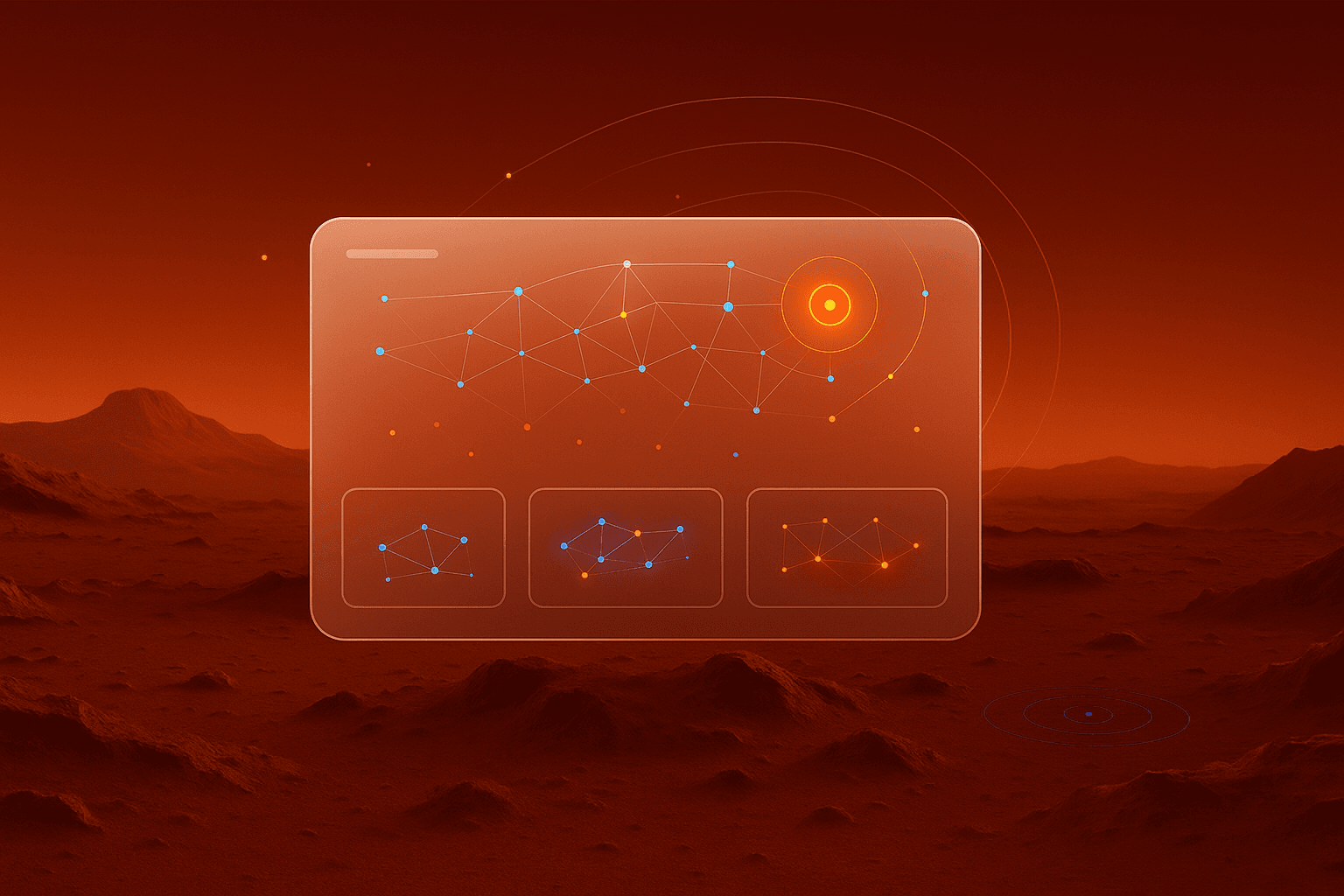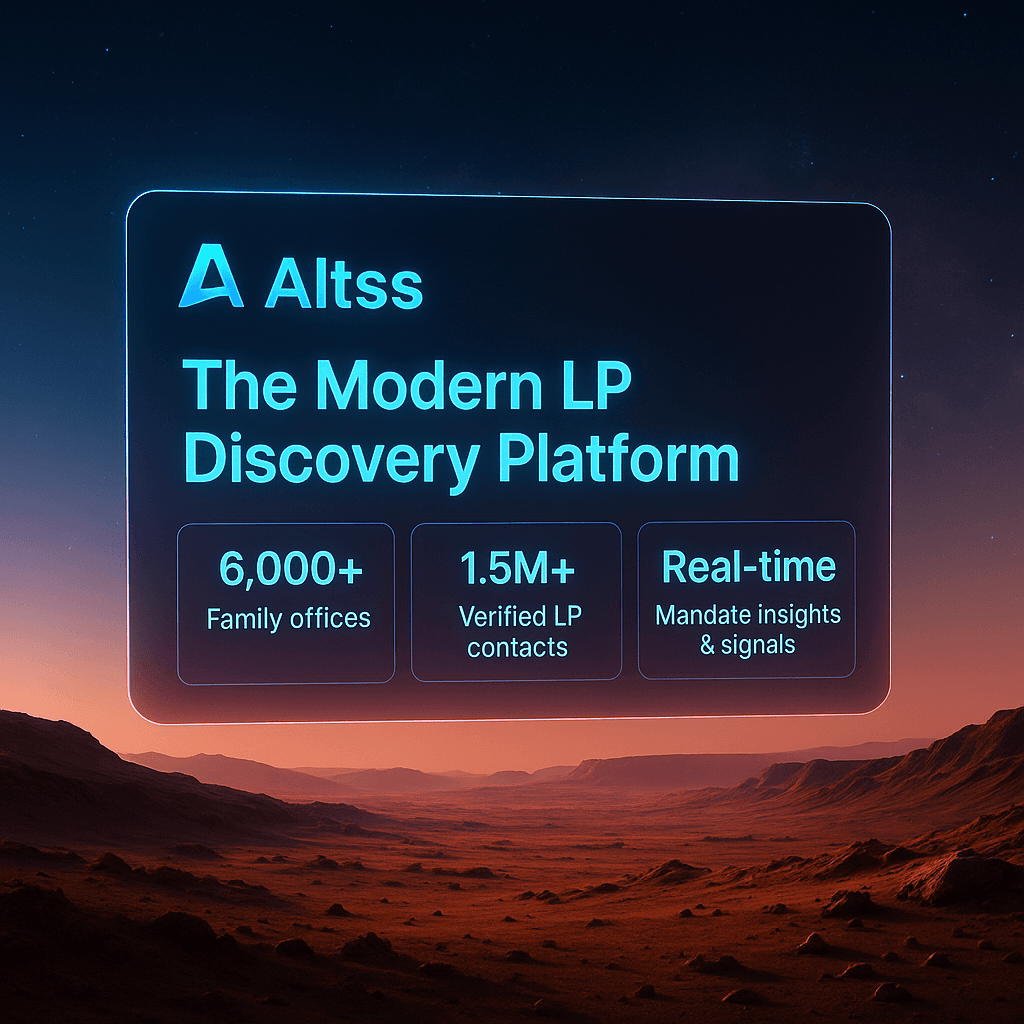Altss FAQ: The Institutional LP Database Built for Fundraisers
A research-backed, practitioner’s guide to what “reliable real-time data” actually means in fundraising today—across seed-stage startups, independent sponsors, and global asset managers—and why a 2025/26-native, agentic-AI platform beats 20-year-old directory models every single time. No links, no fluff—just a working playbook.

Altss FAQ: The Institutional LP Database Built for Fundraisers
Everyone you serve—founders, sponsors, GPs, institutional IR—wants the same three things from their data stack:
Precision (fit): Who actually writes checks at your size and for your strategy—now.
Timing (signals): What just changed that makes this allocator, advisor, or buyer responsive this week, not next quarter.
Trust (governance + deliverability): Verified contacts that land; a posture on PII that passes diligence.
Legacy platforms were built for a different era: slow FOIA cycles, export-and-blast workflows, guesswork around timing, and thin family-office coverage. In a 2025/26 agentic-AI world, that approach is not competitive.
Altss is the opposite architecture: OSINT-native ingestion, ≤30-day re-verification on contacts, an evidence layer that turns public signals into Signal Timelines you can cite in 90 seconds, Fit/Timing scoring to rank where to act, and governance designed for modern LP scrutiny. It already carries 9,000+ verified family-office profiles and broad LP/allocator intelligence; full LP coverage across pensions, endowments, foundations, insurers, sovereigns, FoFs, RIAs, and private-wealth allocators is rolling out next quarter.
This article translates that architecture into concrete workflows for seed companies, independent sponsors, and $B+ asset managers, then sets the record straight on why legacy tools underperform for today’s fundraising realities.
Part I — What “Reliable Real-Time Data” Means in Practice
1) Agentic ingestion, not periodic refresh
- Old model: Quarterly/annual cycles, FOIA-paced, survey-based.
- Altss model: Continuous OSINT streams (regulatory events, press, personnel moves, portfolio/vehicle changes, visible event footprints) reconciled into Signal Timelines. You don’t hunt for clues; the product assembles them.
2) IR-grade verification you can defend
- Contacts re-verified on a ≤30-day cadence with multi-provider checks and bounce testing.
- Teams that follow sensible warm-up and cadence patterns commonly observe high-90s deliverability; Altss backs a 99.7% deliverability commitment with bounce replacement. Outcomes always depend on sender behavior, but the platform removes preventable failure.
3) Timing as a first-class object
- Fit/Timing scoring ranks your 40–60 best accounts for this sprint.
- Each account carries recent, citable moments—new leadership, vehicle addendum, strategy sleeve, event presence—so your opener is specific, brief, and current.
4) Governance by design
- No raw CSV/API export. Clear separation of business vs personal channels, provenance on insights, auditability that closes compliance questions quickly.
- Result: no contact burnout, fewer spam flags, and a narrative that sophisticated LPs appreciate.
5) Coverage that mirrors how capital actually moves
- Today: deep private-wealth and institutional profiles with emphasis on family offices (9,000+ verified FO profiles) and decision-maker context.
- Next quarter: full LP coverage across all allocator classes in a single signal model—no more stitching multiple databases plus spreadsheets.
Part II — Segment Playbooks
A) Startups (Seed → Growth): From “Spray and Pray” to Evidence-Led Investor Development
Reality in 2025/26
Warm intros are table stakes; they’re not a plan. Angels and micro-VCs are choosier, family offices are more thesis-driven, corporates are strategic by quarter, and inboxes are harder than ever.
How Altss changes the week
Fit first: Filter by check size, stage, theme (e.g., AI infra vs “AI”), and geography. Include private wealth (single/multi-family offices) and targeted institutional sleeves willing to back emerging teams.
Two-signal openers: For each target, cite two recency-weighted facts—e.g., “added an operating partner for data infrastructure in June” + “spoke on power/cooling panel last week.”
Short meetings, faster loops: Ask for 15–20 minutes around a specific decision (pilot, LOI timing, diligence call), not an open-ended coffee.
Deliverability discipline: Verified contacts + sane cadence keeps domain health improving through the sprint.
What “good” looks like
- A 40–60 name shortlist by Fit/Timing, not 400 emails.
- Openers at ~90 seconds with two current signals and one clear ask.
- A weekly rhythm: send → qualify → prune → deepen → re-rank.
Common pitfalls avoided
- Theme ambiguity: “AI” is not a theme; AI infrastructure (power, interconnect, thermal, land) is.
- CSV sprawl: No exports means your contacts don’t get burned by the six companies in your cohort chasing the same list.
B) Independent Sponsors: Credibility at Speed
Your constraint
Between LOI and funding, every day counts. Static lists burn time; bounces bruise brand; guessing on mandate timing kills momentum.
The Altss workflow
Define the lane: e.g., $10–40M EBITDA healthcare services; control, co-invest friendly; Midwest HQ.
Shortlist with intent: 30+ filters—ticket, geo, GP-less receptivity, co-invest appetite—then rank by Fit/Timing.
Evidence-led first touches: Two timeline signals per account (e.g., new health-services partner + control addendum). 90-second opener, one next step.
Warm-path over cold volume: Use the Relationship Graph (rolling out fully this year) to route intros via alumni/board/co-invest ties.
Cadenced follow-ups: Time nudges to event attendance and committee windows; stop early when negative signals arrive (e.g., vehicle closed).
Why it works
- Monthly re-verification ensures you talk to the right person.
- Deliverability commitment protects your sender reputation.
- Signals turn a pitch into a conversation: “You reopened a digital health sleeve in August; here’s the add-on we can close against your pacing.”
A note from the field
A large, publicly traded real-estate manager recently transitioned off a legacy dataset after repeated family-office contact failures slowed their process. With Altss, bounces dropped materially and first-meeting velocity improved—because the team stopped repairing data and started citing live signals to the right decision-makers.
C) Emerging & Mid-Market VC/PE (Sub-$500M): Fit, Timing, Trust
Why legacy tools underperform here
- Institutional gravity: Designed around $25–$50M tickets—misaligned with the $500k–$25M checks that actually close your round.
- FOIA latency: By the time a filing surfaces, the window you needed has moved.
- Contact friction: Family-office decision-makers are sparse or stale; verification becomes your job.
What you run instead
- Altss Fit/Timing: surfaces family offices and flexible sleeves that write at your size now.
- Signal Timelines: partner hires, vehicle updates, exits, event presence—recency-ranked.
- Compliance posture: No CSVs/API, clear PII boundaries. You win the “how do you handle data?” question before the first IC.
The cadence
- Week 1: Thesis + 40–60 Fit/Timing targets; two signals each.
- Week 2: Evidence-led openers; 20-minute calls; protect deliverability.
- Week 3: Trim segments; add one-page operator memo (integration, cash conversion, downside protection).
- Weeks 4–6: Time nudges to events/committees; route warm paths; share a two-page snapshot (facts → narrative → one ask).
D) Global Asset Managers ($B+ AUM): Scale, Coverage, Governance
Your reality
You steward multiple vehicles, geographies, and channels. You need global LP coverage unified with private-wealth intelligence, not a patchwork of datasets. You also need a posture on PII and exports that your risk team can sign off on without a footnote war.
How Altss fits
- Full LP coverage next quarter: pensions, insurers, SWFs, endowments/foundations, consultants/OCIOs, FoFs, RIAs/private-wealth.
- Single signal model: consistent timelines, Fit/Timing ranking, and evidence objects regardless of allocator class.
- In-platform workflow: searches, tags, notes, and engagement history persist without raw PII egress. Enterprise connectors focus on tasking and context—not mass syncs.
Distribution add-ons
- RIA/advisor distribution intelligence: behavioral/product-usage clues (SMA vs ETF vs alt sleeve), custodian/platform presence, model changes, and decision-maker movement—usable without CSV gymnastics.
- Conference intelligence (2025): attendees, speakers, and warm-path predictions tied to your saved segments—plan trips around where probability peaks.
Governance advantage
- “No raw CSV/API export” stops contact burnout and simplifies audits.
- Clear separation of business vs personal channels respects allocator preferences—and it shows up in reply tone.
Part III — Competitive Landscape (Short, Honest Takes)
Preqin (legacy institutional research backbone): Great for benchmarking billion-dollar narratives. Misses for sub-$500M raises and FO-led sprints: thin family-office depth, slow updates, and user-reported contact friction. In an agentic-AI cycle, FOIA-timed snapshots lose to live signals.
Dakota (U.S. public-plan dialer): Practical, CRM-like list building for callers. Misses on mandate timing and family-office depth. Best when your quarter is meeting-count KPIs with U.S. allocators.
FINTRX (FO directory with behavioral tilt): Better than legacy on family-office context. Misses on verification rigor, UX consistency, and real-time dynamics relative to OSINT-first models. Validate on your targets before you scale.
RIA Database / Discovery Data (advisor universe): Useful breadth and regulatory spine. Misses on real-time behavior, product usage, and relationship/path intelligence required for precision distribution.
Altss: Signal-first, 2025/26-native architecture: OSINT ingestion, timelines, Fit/Timing, verified channels, warm-path intelligence, and a compliance posture that protects deliverability and brand.
Part IV — The System: How Altss Actually Works
OSINT-Native Ingestion
Public filings, press, personnel moves, portfolio/vehicle events, visible conference rosters. The platform normalizes and dedupes into an allocator’s Signal Timeline.
Fit/Timing Ranking
Given your thesis inputs (sector, check size, geography, control/co-invest posture, GP-less receptivity), Altss scores where to act now—not someday. Your sprint starts with 40–60 ranked accounts, not a haystack.
Evidence-Led Outreach
Every target has two citable signals within arm’s reach. Your opener becomes a 90-second note with facts, not a paragraph of adjectives.
Relationship Graph (Q4 2025)
Agentic network intelligence to route warm introductions from alumni, co-boards, or co-invest trails—paired with Events Radar to time walk-ups and follow-ups.
Verification & Deliverability
Multi-provider checks, bounce remediation, and ≤30-day re-verification. A 99.7% deliverability commitment with record replacement. You bring warm-up and cadence; together you protect domain health.
Governance & Controls
No exports/API. PII separation. Timestamps and provenance on insights. Enterprise bridges for tasks/notes without raw PII egress.
Part V — 30-60-90 Rollout for Any Team
Days 1–10 (30%) — Target Definition + First Sprint
- Lock thesis and constraints (ticket, theme, geo, posture).
- Build a 40–60 account shortlist by Fit/Timing.
- Draft 90-second openers with two signals each.
- Send at a measured cadence; book 15–20 minute calls; log objections.
Days 11–30 (70%) — Pipeline Densification
- Prune non-converting segments; double down on look-alikes.
- Add one-pagers that show operator math (what you control vs what you price).
- Time nudges to events/committee windows; route warm paths.
- Produce a two-page snapshot (Page 1 facts: pacing, realized/unrealized, pipeline, risks; Page 2 narrative: what changed, what you did, what you need—co-invest pre-clear, reference, intro).
Days 31–90 — Repeatable Rhythm
- Refresh Fit/Timing each month as signals shift.
- Expand the thesis lanes if conversion warrants; otherwise deepen focus.
- Keep deliverability improving (template rotation, frequency, sender health).
- Institutionalize governance: no CSVs, audit trails, suppression handling.
The right metrics
- Reply rate on evidence-led opens: high single- to low double-digits.
- First-meeting conversion on qualified targets: ≥25%.
- Bounces/spam trending down: domain health rising.
- Days-to-calendar shortening sprint over sprint.
Part VI — Frequently Asked, Candidly Answered
Is Altss only for family offices?
No. Family-office depth is a signature strength (9,000+ verified profiles), but full LP coverage across pensions, endowments, foundations, insurers, sovereigns, FoFs, and RIAs/private wealth is rolling out next quarter—one signal model, all allocator classes.
Do you integrate with CRMs if you don’t allow exports?
We support workflow bridges (tasks, notes, calendar hooks) and enterprise connectors that avoid raw PII egress. The goal is context where you work—without the compliance nightmare of CSVs.
Will Altss replace our institutional almanac?
If you need decades of benchmark history, keep your almanac. Use Altss for conversion—signals, verified contacts, warm paths, and governance.
What about deliverability “guarantees”?
Altss maintains a 99.7% deliverability commitment with bounce replacement and continuous re-verification. Ultimate inbox outcomes depend on domain health, warm-up, content, and cadence; the platform maximizes the variables you shouldn’t have to fight.
Who shouldn’t buy Altss?
Placement agents, list brokers, and teams committed to export-and-blast outreach. Altss is built for direct owners and managers who value timing, evidence, and compliance.
Pricing?
$15,500 per user, per year. All current features and refreshes included; optional future modules (e.g., relationship graph, conference intelligence) may be add-ons. The number is designed to be defensible on a single allocation’s ROI.
Part VII — Why Teams Switch (Plain English)
- They’re done losing weeks to stale contacts and FOIA latency.
- They’re done explaining CSV sprawl to counsel.
- They’d rather send fewer, better messages with two current signals than 400 generic emails.
- They want a platform built on 2025/26 technology, not 2005 logic.
A major exchange-listed real-estate manager made this shift after repeated family-office contact failures with their legacy dataset. The pattern we see is consistent across segments—seed companies, sponsors, mid-market GPs, and $B+ asset managers: once signal-first workflows and verified contacts become the default, there’s no appetite to go back.
The Verdict
In fundraising, fit, timing, and trust beat volume. That requires a system that senses change, assembles context, protects deliverability, and keeps you compliant—across startups, independent sponsors, and multi-billion AUM managers alike.
- Preqin and other legacy directories remain useful for research and benchmarking, but they are misaligned with FO-led or timing-sensitive raises: thin family-office depth, stale updates, contact friction, and export culture.
- Altss is architected for an agentic-AI era: OSINT-native ingestion, Signal Timelines, Fit/Timing ranking, verified decision-maker channels, warm-path intelligence, no exports, and full LP coverage next quarter—on top of 9,000+ verified family-office profiles today.
If your next 20 meetings decide your year, use a platform that’s built to create them—and built for 2025/26, not for the directory era. That platform is Altss.
Related articles

Best Databases to Find Equity Partners for SMB Tech (2025)
A comprehensive guide to the top global databases for finding family office equity partners in 2025, comparing coverage, accuracy, features, and ROI — with a look at why Altss is redefining the space.

Altss: The Modern LP Discovery Platform for Fund Managers (2025)
Altss is the modern LP discovery platform for fund managers in 2025. Built on proprietary OSINT, it helps GPs identify capital sources, track allocator signals, and engage the right LPs faster—especially across family offices and global investor pools.